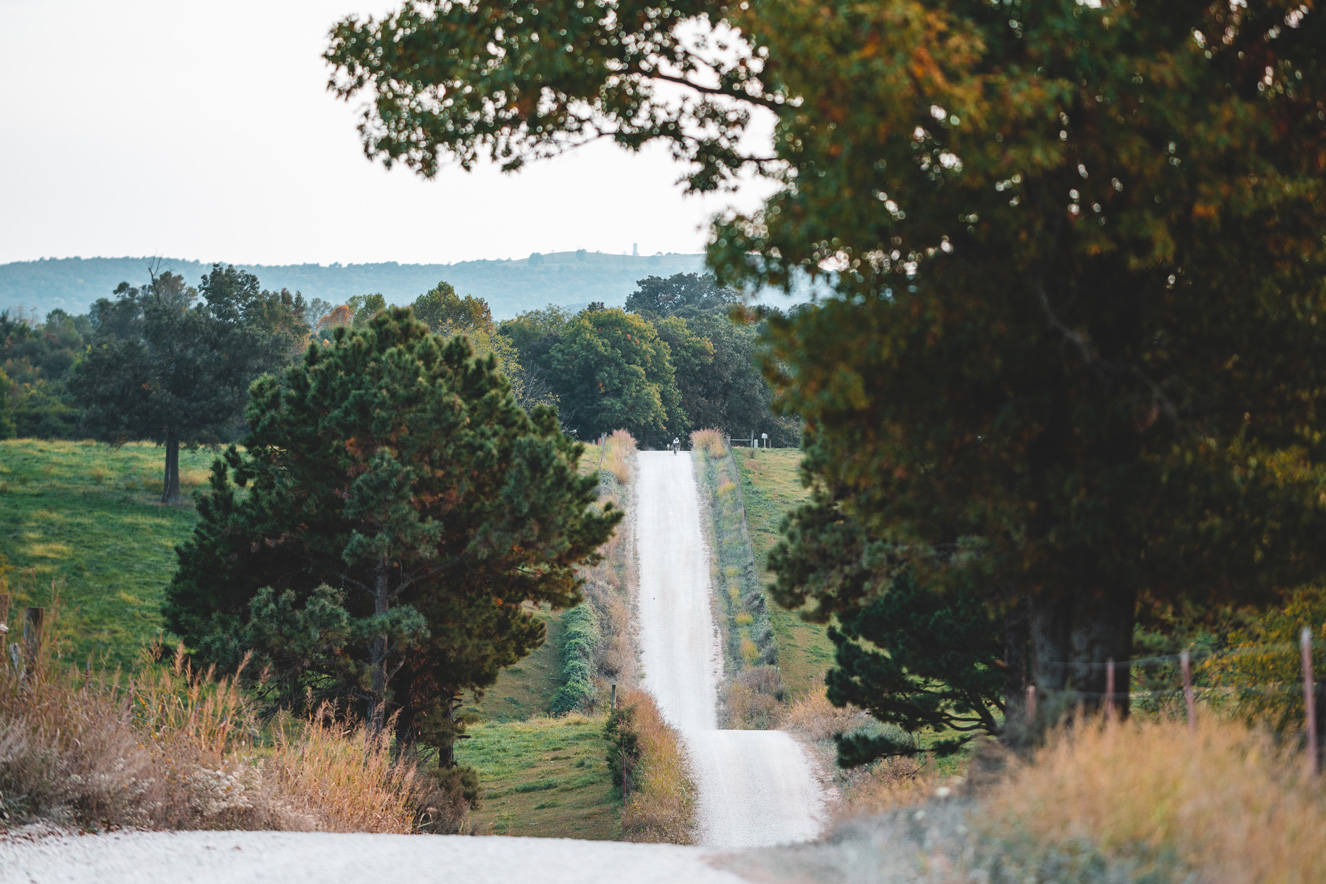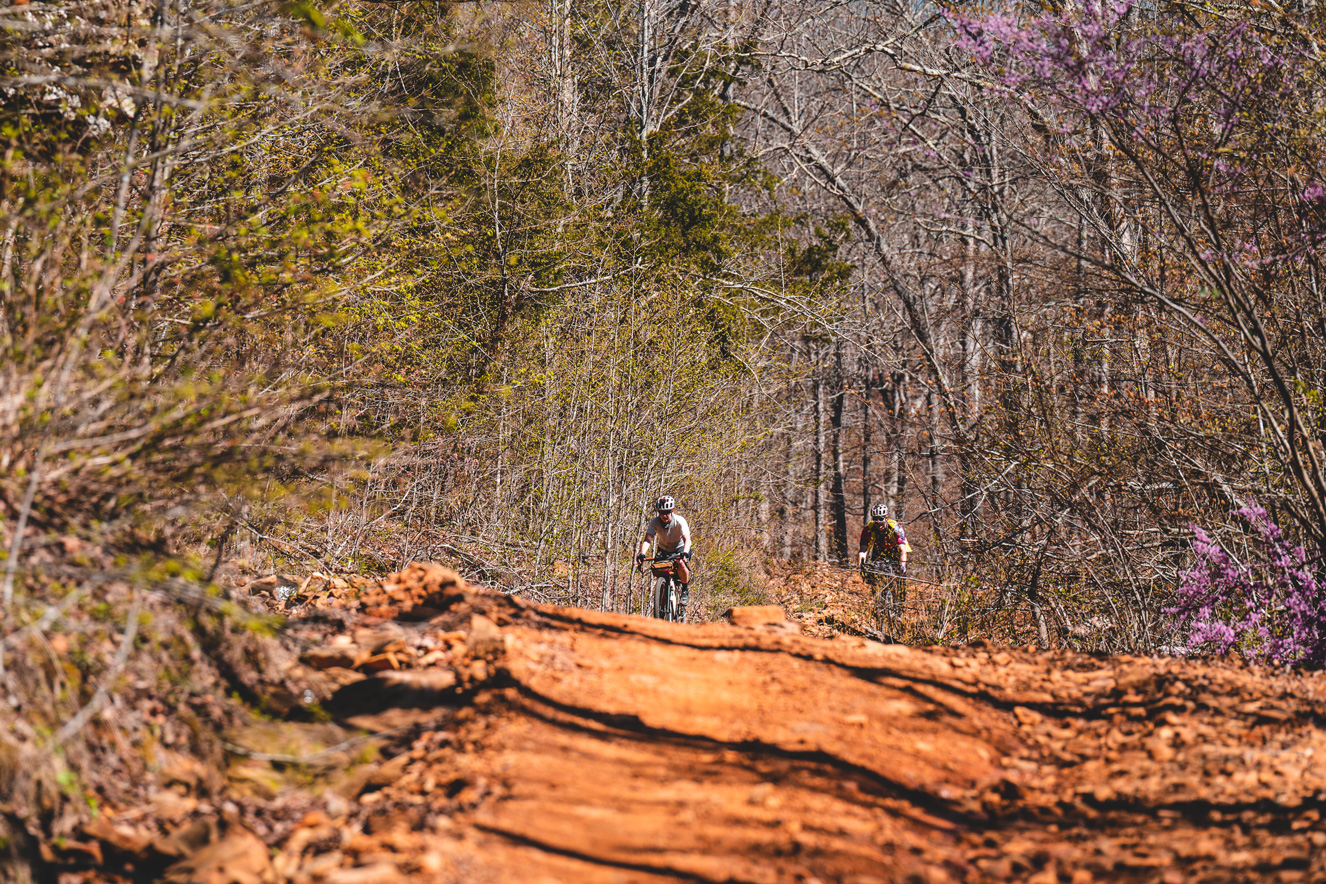Gravel Riches Await in The Natural State
No shortage of scenic adventure off the beaten path in Arkansas.
By Brannon Pack | Photography by Kai Caddy

ROLLING HILLS: In the Ouachita National Forest.
Like the oil booms of the early 20th century, gravel road cycling is having its own “Gusher Age” as more and more cyclists turn to rural gravel roads for recreation. Merging the inclusive culture of mountain biking with the lively group riding of road cycling, cyclists are drawn to the low traffic density, rewarding scenery and welcoming spirit of gravel — where shared experiences are celebrated and last place in a race is as much an honor as first.
And in Arkansas, we are gravel rich. According to the Federal Highway Administration, Arkansas has 173,000 miles of rural roads, the 10th most of any state. Of those rural roads, a staggering 69,000 miles remain unpaved, according to the Arkansas Department of Agriculture — and that doesn’t account for the extensive network of gravel forest roads winding through 2.9 million acres of National Forest lands in the state.
The creation of an interstate system in the 1950s left Arkansas’s rural areas largely unchanged. Today, over 85% of Arkansas’s county roads are still gravel — creating a wealth of scenic gravel road riding opportunities across a rustic landscape.

EVEN THE COWS HAVE TO CLIMB: Rolling pastures near Kingston.
Uncover Scenic Treasures
While the lower traffic density found on our gravel backroads is welcome, it is access to Arkansas’s distinct natural regions that is driving the state’s gravel boom. The geography of Arkansas changes extensively as mountain ranges in the north and west give way to the river valleys, lakes and Delta farmlands in the east. And much like the oil boom, rural communities with direct access to gravel roads are becoming popular hubs for larger gravel experiences — and increasing cycling tourism throughout the state.
In Northwest and North-Central Arkansas, the Ozark Mountains form the greatest relief of any mountain range between the Rocky and Appalachian mountains with summits towering 2,500 feet over the valleys below. For cyclists, the Ozark National Forest spans over 1 million acres of public lands where forest canopy covers the road and gravel riding opportunities are endless. Known as one of America’s most scenic areas, gravel roads often line the many waterways that originate in the Ozarks, including the Kings, Mulberry, Little Red, White and Buffalo rivers.
Western Arkansas is home to the Ouachita Mountains and the Ouachita National Forest, one of the largest and oldest national forests in the South. The Ouachitas are a continuous chain of east-west mountains that form rolling ridges of gravel stretching westward from Central Arkansas to the Oklahoma border. While most cyclists will find traversing the steep north and south slopes of the Ouachita Mountains challenging, lengthy forested ridgelines create a gratifying gravel experience.
From its headwaters in the Rocky Mountains, the Arkansas River divides the Ouachita and Ozark mountains to form the Arkansas River Valley. From the valley floor, winding gravel forest roads lead up and over the state’s highest mountains, including Mount Magazine, Arkansas’s highest peak at 2,753 feet. As the state’s central destination for gravel cyclists, the River Valley boasts access to Arkansas’s most popular state parks, scenic overlooks and all-day gravel adventures for you and your crew.
Toward the east is Crowley’s Ridge and the Arkansas Delta. Crowley’s Ridge is a narrow rolling ridgeline that cuts north-south through the Delta, where undulating gravel roads and farmland levees continue to grow in popularity with cyclists. Skirting Arkansas’s easternmost boundary, the Delta Heritage Trail is an 85-mile gravel rail-to-trail being developed along the historic Union Pacific Railroad and portions of the Mississippi River levee systems.
From cruising mountainous ridgelines to meandering through Delta farmlands, Arkansas offers gravel cyclists an unparalleled diversity of natural terrain to explore, and with a calendar filled with gravel events, cyclists are experiencing The Natural State like never before.

CHUNKY: A chunky descent with more dirt than gravel near Nail.
A Wealth of Gravel Events
Access to normally remote landscapes, varying course distances and finish line parties celebrating the efforts of everyone have driven the popularity of mass start, gravel specific events — and Arkansas is gushing with gravel races and rides across the state.
With the Ozarks as a playground, Northwest Arkansas boasts an abundance of well-known gravel races, including the Rule of Three, the Highlands Gravel Classic and the Big Sugar Gravel. New this September is the Ozark Randonneur, a timed gravel tour featuring long-distance routes wandering through the Ozark Mountains east of Fayetteville. A unique format that pits racers against the clock and not one another, participants of the Ozark Randonneur can work together to finish ahead of the event’s cut-off time — with 122-mile and 201-mile route options.
From the Ouachitas to Central Arkansas, gravel riding opportunities of all sizes shape the calendar, including in Hot Springs, where the annual Arkansas High Country Race — a 1,000-mile journey — continues to grow in notoriety as one of the most challenging gravel bikepacking races in the country. Beginning from Hot Springs’ historic Bath House Row this fall, participants have the option to compete in a shorter 500-mile distance highlighting the natural beauty of the Ouachita Mountains.
Arkansas-based gravel events run deep into the Arkansas Delta and along Crowley’s Ridge, where events like the Birdeye Gravel Festival are reimagining rural experiences. Featuring a weekend of gravel riding from a private, eight-acre farm in Birdeye, each day of this fall festival offers unique gravel experiences complemented by freshly made meals, local musicians and fire pits to gather around late into the evenings.
Complementing a continuous calendar of gravel events, traditional road cycling clubs have begun including gravel options in their weekly ride schedule — with local coffee shops and craft breweries among the favorite gathering spots for most casual group rides. Organizations like Experience Fayetteville and Arkansas Tourism are investing in gravel route development to encourage cycling tourism across the state, and gravel focused nonprofits like the Ozark Gravel Cyclists are fostering a diverse community of adventure cyclists through hosted group rides, events and route development.

GOING UP: There’s plenty of climbing to be had in the Ozarks.
A Historical Destination
Gravel roads in Arkansas are often linked to history, including the westward expansion of the United States, the forced displacement of Indian tribes from the Southeast, and the American Civil War with stories of remote outlaw hideouts and war-era buried treasures common throughout the state. Here, picturesque gravel roads descend into unincorporated communities dating back to the 1800s as traces of Civil War battlefields line the landscape and time itself seems to stand still.
Fast rolling gravel roads often skirt past the ghostly remains of one-room schoolhouses and through the historical townships that served as battlelines for conflicts that once determined the future of our country. What survived the Civil War is a testament to American craftsmanship, and these historical structures, many on the National Register of Historic Places, provide a stark contrast to the natural treasures in the state.
From postcard worthy views in the Ozark and Ouachita mountains to the warm hospitality of our rural communities across the state, Arkansas should be on every gravel cyclist’s bucket list. In Arkansas, diverse natural scenery intersects with American history and waits to be discovered on our gravel roads.


